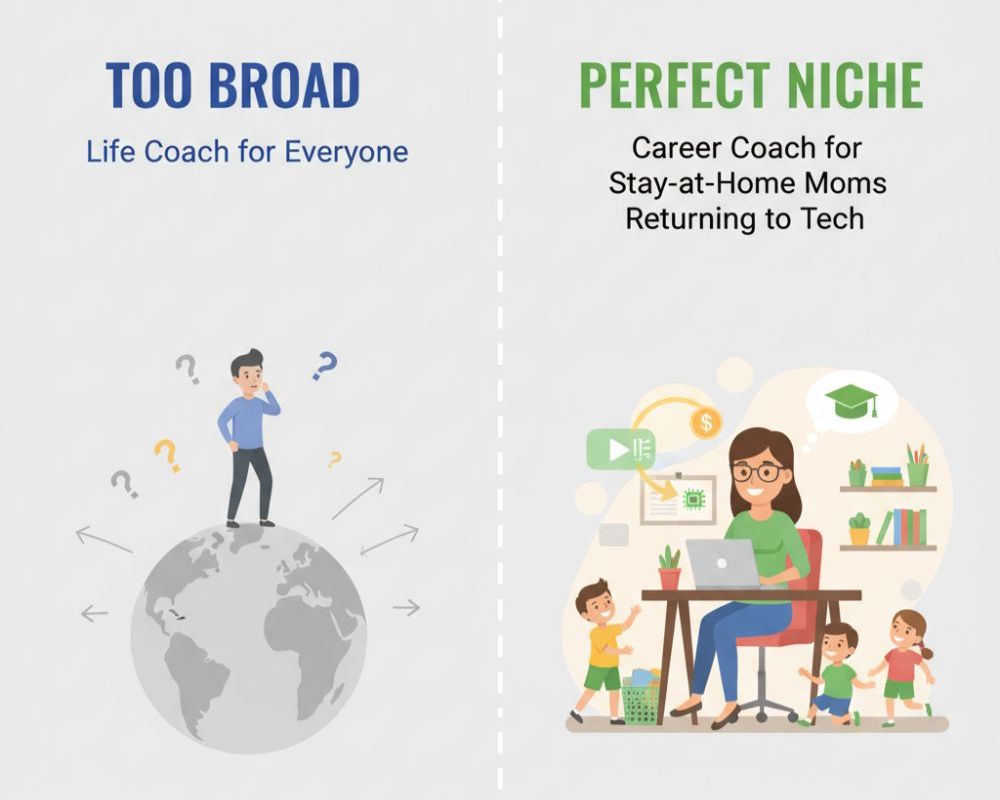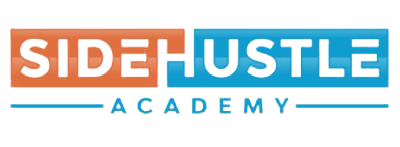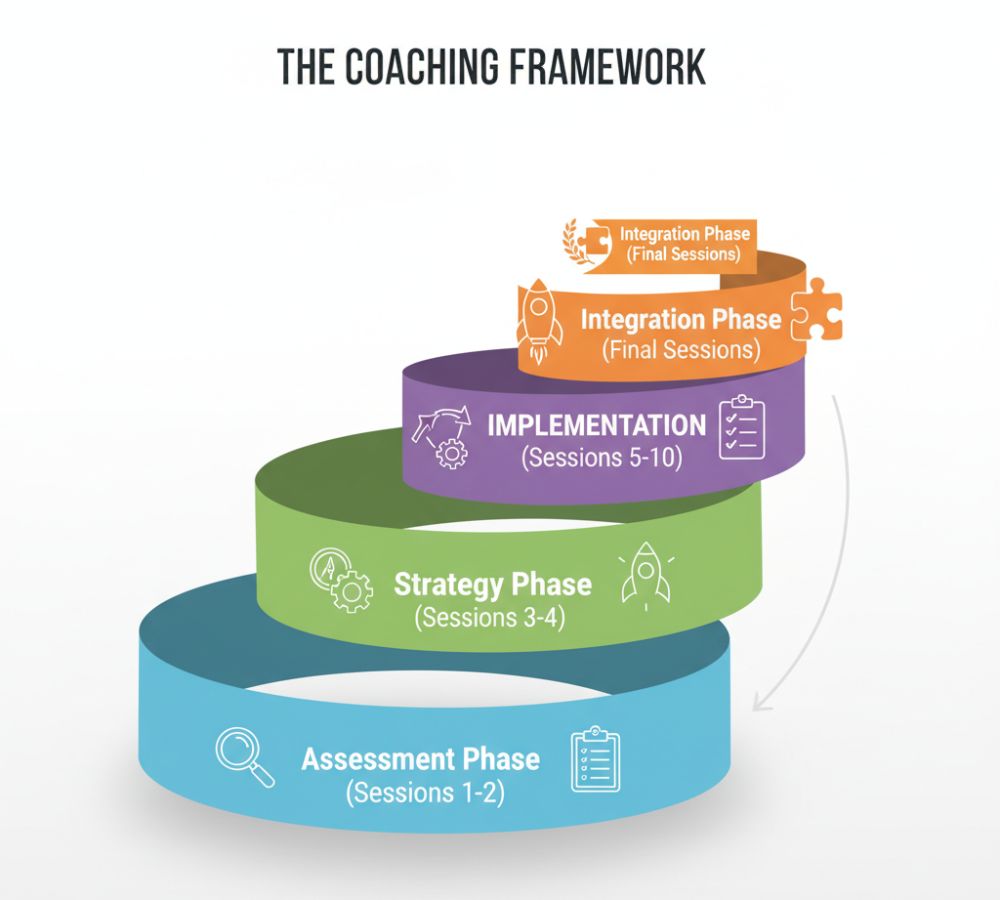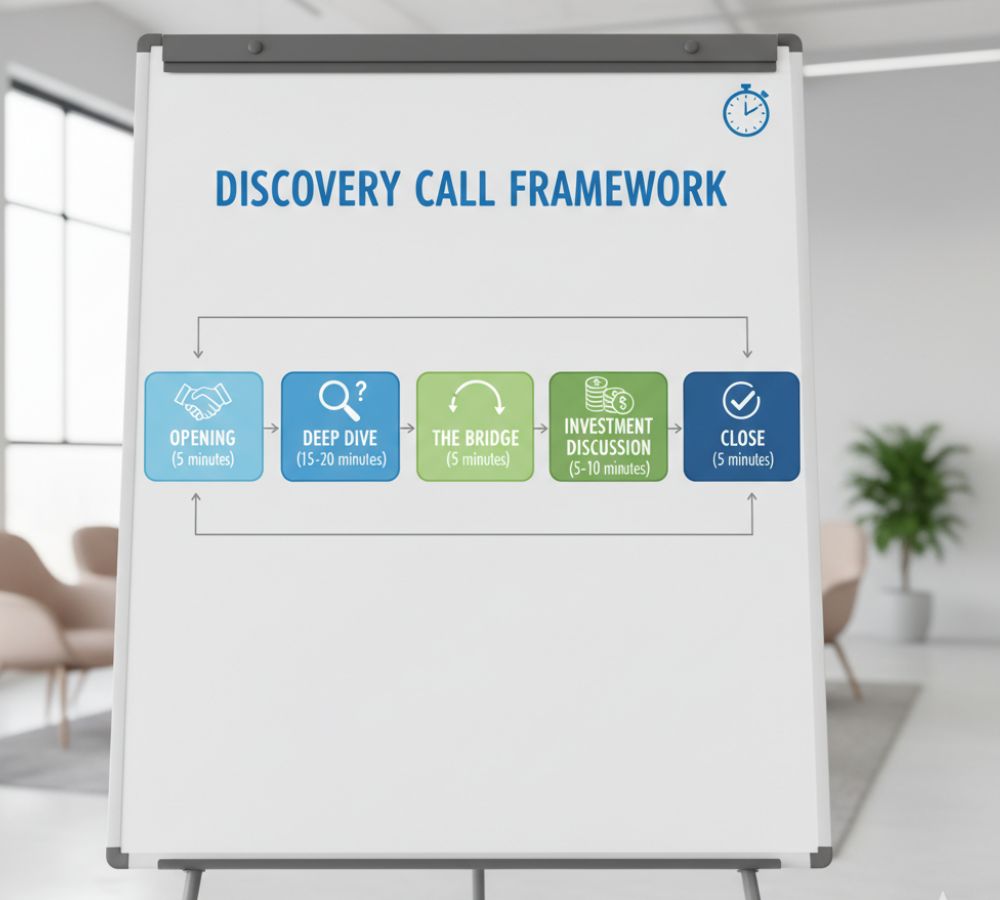Make Money Doing One-on-One Coaching: A Complete Guide
If you want to make money doing one-on-one coaching, it isn’t rocket science, but it’s not exactly a walk in the park either. I’ve seen people transform their expertise into six-figure coaching practices, and I’ve watched others struggle to land their first client. The difference? They followed a system.
To make money doing one-on-one coaching, first identify your expertise and target audience, then set clear pricing based on the value you provide and market rates. Promote your services through social media, a simple website, and by asking satisfied clients for referrals. Schedule sessions consistently, deliver genuine value by helping clients achieve specific results, and gradually raise your rates as you gain experience and testimonials.
If this sounds like a lot, don’t worry, I’ll break down exactly how to turn your expertise into a legitimate income stream through one-on-one coaching.
Step 1: Find Your Coaching Niche (And Stop Being Everything to Everyone)
This is where most aspiring coaches often fall short. They say stuff like, “I coach anyone who wants to improve their life!” Cool story. That’s like opening a restaurant that serves “food.” What kind of food? For whom? Why should they care?
Your coaching niche should sit at the intersection of three things:
- What you’re genuinely good at
- What people will actually pay for
- What you won’t hate doing repeatedly
I know a coach who tried to be a “general life coach” for two years and made roughly $3,000 total. Then she niched down to “career transitions for women in tech, leaving corporate jobs” and made $87,000 in her first year. Same person, same skills—completely different positioning.
Here’s how to nail your niche:
Ask yourself these essential questions:
- What problems have you personally solved that others struggle with?
- What do friends constantly ask your advice about?
- What topic could you discuss for three hours without getting bored?
Your coaching niche might be executive coaching for mid-level managers, accountability coaching for entrepreneurs, or personal development coaching for recent college graduates. The more specific you are, the easier it is to market yourself and the higher you can charge.

Step 2: Structure Your Coaching Packages (Because Hourly Rates Are Amateur Hour)
Let me tell you something most new coaches learn the hard way: selling one-off coaching sessions is exhausting and unprofitable. You’re constantly hustling for the next client, your income is wildly unpredictable, and clients don’t get real results from random sessions.
Instead, you want to create coaching packages that bundle multiple sessions together. This is better for everyone—clients get committed support that actually transforms their situation, and you get predictable revenue and deeper relationships.
The standard coaching package structure looks like this:
Starter Package (4-6 weeks)
- 4 bi-weekly coaching sessions (60 minutes each)
- Email support between sessions
- Session notes and action items
- Price range: $800-$1,500
Signature Package (12 weeks)
- 12 weekly coaching sessions
- Unlimited email support
- Custom frameworks and tools
- Progress tracking dashboard
- Price range: $2,500-$5,000
Premium Package (6 months)
- 24 sessions (bi-weekly)
- Priority access and support
- Personalized program materials
- Quarterly reviews and adjustments
- Price range: $6,000-$15,000
Notice how the longer packages have better margins? That’s intentional. You want to gently nudge clients toward bigger commitments because that’s where transformation actually happens.
Step 3: Set Your Coaching Prices (Without Underselling Yourself)
Alright, this is where things get uncomfortable. How much should you charge for coaching sessions? The answer is probably more than you think, but we need to be strategic about it.
Here’s the reality: if you charge $50 per hour, you’re positioning yourself as an amateur. Even if you’re brand new to coaching, you’re bringing years of life experience, expertise, and insight to the table. That’s valuable.
Pricing guidelines based on experience:
| Experience Level | Per Session | Monthly Package | 3-Month Program |
|---|---|---|---|
| New Coach (0-1 year) | $75-150 | $600-1,200 | $1,500-3,000 |
| Established Coach (1-3 years) | $150-300 | $1,200-2,400 | $3,000-7,000 |
| Expert Coach (3+ years) | $300-500+ | $2,400-4,000+ | $7,000-15,000+ |
Remember, you’re not charging for your time—you’re charging for the transformation you provide. A client who increases their income by $30,000 after working with you will happily pay $5,000 for that coaching.
Start at a price that feels slightly uncomfortable (that’s how you know it’s right), and raise your rates as you gain testimonials and results. I typically recommend increasing prices by 15-20% every six months or after every five clients.
Step 4: Set Up Your Coaching Toolkit (The Tech That Actually Matters)
You don’t need fancy software to start coaching, but you do need a few essential tools to look professional and stay organized. Here’s what actually matters:
1. Scheduling and Video Platform
Invest in an all-in-one solution that handles calendar bookings, sends automated reminders, and hosts your video sessions.
This saves you countless hours of back-and-forth emails and reduces no-shows by about 70%. Look for platforms that integrate payment processing too—getting paid should be automatic, not awkward.
For scheduling, I prefer Calendly; it’s simple to use and has a free plan. For a video platform, I prefer Zoom with its free plan option.
2. Client Relationship Management
You need a system to track client goals, session notes, homework assignments, and progress.
Even a simple spreadsheet works at first, but a dedicated coaching CRM will save your sanity once you have more than 10 clients. The best ones include session note templates and progress tracking dashboards.
For this, I recommend a Google WorkSpace Account that will give you a dedicated email address and allow you to keep all your client stuff in one place.
3. Payment Processing
Make it ridiculously easy for clients to pay you. Set up a system that accepts credit cards, allows payment plans, and sends professional invoices.
The harder you make it to pay, the fewer people will actually hand over their money.
For payment processors, I prefer PayPal and Stripe. They are free to use and easy to set up.
4. Intake and Onboarding System
Create automated intake questionnaires that gather essential information before your discovery calls.
This saves time and helps you show up prepared. Include questions about their goals, challenges, previous coaching experience, and what success looks like to them.
For this, I also prefer Calendly. No need to have more tools than you really need.
Step 5: Design Your Coaching Framework (Your Secret Sauce)
Here’s what separates professional coaches from people who just “give advice”—a repeatable framework. Your coaching framework is the structured approach you use to guide clients from point A to point B.
Think of it like a roadmap. You’re not making it up as you go along (even though you’ll definitely adapt to each client). You have a proven system that works.
A solid coaching framework includes:
Assessment Phase (Sessions 1-2): Figure out exactly where the client is starting from. What’s working? What’s not? What have they already tried? What beliefs are holding them back? This is diagnostic work—you’re gathering data.
Strategy Phase (Sessions 3-4): Based on your assessment, you’re creating a customized plan. What are the specific goals? What milestones matter? What’s the timeline? This is where you demonstrate your expertise by connecting dots they can’t see.
Implementation Phase (Sessions 5-10): This is the meat of your coaching. You’re working through obstacles, celebrating wins, adjusting strategies, and holding clients accountable. Each session builds on the previous one.
Integration Phase (Final sessions): You’re ensuring the changes stick. How will they maintain progress without you? What systems need to stay in place? This is about creating sustainable transformation, not dependency.
Having this framework makes you confident in your coaching sessions because you always know what to focus on next.
Step 6: Master the Discovery Call (Where Money Actually Gets Made)
Let’s talk about the discovery call—that initial conversation where a prospect decides whether to work with you or not. This is literally where your coaching business lives or dies, so pay attention.
First, ditch the mindset that discovery calls are “free consultations” where you solve all their problems. That’s ridiculous. You’d be giving away your most valuable asset (your brain) for free. Instead, discovery calls are mutual evaluation sessions.
Here’s a discovery call script that actually converts:
Opening (5 minutes): Build rapport. Ask about their day. Find a genuine connection point. People buy from people they like, so be a human, not a sales robot.
Deep Dive (15-20 minutes): Ask powerful questions that reveal the real problem:
- “What made you reach out right now?”
- “What’s the gap between where you are and where you want to be?”
- “What happens if nothing changes in the next six months?”
- “What have you already tried?”
Listen more than you talk. Take notes. Show genuine interest.
The Bridge (5 minutes): Explain how your coaching framework addresses their specific situation. This isn’t generic—you’re connecting their exact problems to your exact solutions. “Based on what you’ve shared, here’s how we’d work together…”
Investment Discussion (5-10 minutes): Present your coaching packages. Start with the one you think fits best. Explain the investment (don’t say “cost”—it’s an investment in themselves). Handle objections calmly. If they need to “think about it,” that usually means they’re not convinced, so dig deeper into their hesitation.
Close (5 minutes): If they’re ready, walk them through the next steps. If not, respect that and follow up in a few days.
The key? You’re qualifying them as much as they’re qualifying you. Not everyone is a good fit for coaching, and that’s okay.
Step 7: Market Your Coaching Services (Without Being That Annoying Person)
Alright, you’ve got your niche, packages, and framework. Now you need actual clients. Marketing coaching services feel awkward for most people because nobody wants to be “salesy.” I get it. But here’s the thing—if you truly believe your coaching helps people, then not marketing it is selfish.
Content Marketing (The Long Game) Start sharing valuable content related to your coaching niche. Start a blog, create social media content, record videos, start a newsletter—whatever medium feels natural. The goal is to demonstrate expertise and build trust before asking for money.
Referral System (The Fast Game) Your best clients come from referrals. Period. Ask every satisfied client, “Who else do you know struggling with [specific problem]?” Offer a referral incentive if it feels right—maybe a free session or discount on their next package.
Strategic Networking: Join communities where your ideal clients hang out. Facebook groups, LinkedIn communities, local meetups, and industry conferences. Don’t spam them with your services. Instead, be genuinely helpful, answer questions, and build relationships. The coaching offers come naturally from there.
Simple Lead Magnet: Create a free resource that solves a small problem related to your coaching. A PDF guide, a checklist, a mini email course—something valuable that requires an email to access. This builds your list of potential clients you can nurture.
Take the time to decide how you are going to find clients. Start with one method and build a framework that leads people to you.
Step 8: Deliver Exceptional Coaching Sessions
Once you land clients, the real work begins. Here’s how to structure effective coaching sessions that get results:
Pre-Session Prep (5-10 minutes) Review your notes from the last session. What commitments did they make? What were they struggling with? Going into each session prepared shows you care and maximizes the value.
Session Structure (60 minutes)
Opening Check-In (5-10 minutes) “How are you? What’s happened since we last talked?” This isn’t small talk—you’re gathering data and building rapport.
Progress Review (10-15 minutes) “What actions did you take? What worked? What didn’t?” Celebrate wins and explore obstacles without judgment.
Core Work (25-30 minutes) This is where transformation happens. You’re asking powerful questions, reframing limiting beliefs, exploring new perspectives, and co-creating strategies. This isn’t advice-giving—it’s guided discovery.
Action Planning (10 minutes) “What are you committing to before our next session?” Be specific. Make it measurable. Ensure it’s achievable.
Closing (5 minutes): Summarize key insights, confirm the action plan, and schedule the next session.
Post-Session Follow-Up: Send session notes within 24 hours. Include key insights, action items, and any resources you mentioned. This keeps clients accountable and reinforces the value they’re receiving.
Quick Tip: Put systems in place to help you get things done fast. Have prewritten templates in place that allow you to fill them out quickly and back to your clients shows you are fast and responsive.
Step 9: Measure Progress and Demonstrate ROI
Clients need to see they’re making progress, and you need proof that your coaching works. This isn’t just about feeling good—it’s about retention, referrals, and raising your rates.
Track Meaningful Metrics:
- For business coaching: Revenue growth, time saved, deals closed, promotions earned.
- For life coaching: Habit consistency, relationship quality scores, and confidence ratings.
- For health coaching: Measurable health markers, consistency metrics, and energy levels.
Create simple progress tracking tools. Quarterly reviews work great—you’re comparing where they started to where they are now. The contrast is usually dramatic, and it reminds clients why they’re investing in coaching.
I’ve seen coaches use simple Google Forms to collect weekly progress updates, and others use sophisticated dashboards. Find what works for your style, but make progress visible and tangible.
Step 10: Scale Your Coaching Income (Beyond Trading Time for Money)
Here’s the truth: Making money doing one-on-one coaching has an income ceiling because you only have so many hours. Even at $500 per session, there’s a cap on what you can earn. So how do you scale?
Raise Your Rates Regularly. Every six months or after every 5-10 clients, increase your prices by 15-20%. Your existing clients stay at their current rate (honor your commitments), but new clients pay more. This is the simplest way to increase income without working more hours.
Create Group Coaching Programs. One-to-many coaching lets you serve more people while maintaining intimacy. A group program with 10 people paying $1,500 each generates $15,000 versus serving them individually for $150 each ($1,500 total). The math is compelling.
Develop Digital Products. Turn your coaching framework into courses, templates, workbooks, or assessment tools. These require upfront work but create passive income streams.
Train Other Coaches. Once you’ve proven your methodology works, teach other coaches how to use it. Licensing your framework or offering certification programs creates leveraged income.
Add Accountability Coaching. Offer optional add-ons like mid-week email check-ins, text coaching, or brief calls between sessions. These small additions can add $200-500 per client monthly.
Common Obstacles (And How to Actually Overcome Them)
Let’s address the elephants in the room—the stuff that stops most coaches before they even start.
“I don’t have credentials or certification.” Here’s a secret: most successful coaches don’t have formal certifications. What matters is results and testimonials. That said, if you want credibility in certain niches (executive coaching, health coaching), consider getting certified. But don’t let a lack of credentials stop you from starting.
“No one will pay me for this.” They will if you’re solving a problem they desperately want solved. The issue isn’t whether people will pay—it’s whether you’re making the value clear and targeting the right audience.
“I’m not confident enough yet.” Confidence comes from doing, not waiting. Start with discounted “beta clients” if you need to. Use their feedback and results to build your confidence and testimonials.
“How do I handle no-shows and cancellations?” Have a clear cancellation policy in your contract. Typically, 24-48 hours’ notice is required for rescheduling, or the session is forfeited. This protects your time and teaches clients to respect commitments.
“What if I can’t help someone?” Refer them to someone who can. Building a network of other coaches and professionals makes you more valuable, not less. Sometimes the best coaching is knowing when you’re not the right fit.
The Ethical Foundation (Don’t Skip This Part)
Real talk. Coaching comes with responsibility. You’re influencing people’s decisions, beliefs, and actions. Here are non-negotiable ethical guidelines:
Stay in Your Lane Coaching is not therapy. If someone needs mental health support, refer them to a licensed professional. Know the difference and respect those boundaries.
Maintain Confidentiality. Everything shared in coaching stays confidential unless there’s a safety concern. Period. No gossiping, no sharing “anonymous” client stories that are clearly identifiable.
Avoid Dual Relationships. Don’t coach friends, family, or people you have other significant relationships with. The boundaries get messy, and the coaching suffers.
Keep Growing. Invest in your own development. Read books, take courses, and get your own coach or mentor. You can’t lead clients further than you’ve gone yourself.
Honest Marketing. Don’t make promises you can’t keep. Don’t fabricate testimonials. Don’t use manipulative sales tactics. Build your business on integrity, or you won’t have a business worth building.
Your 90-Day Action Plan to Launch Your Coaching Business
Okay, let’s make this concrete. Here’s exactly what to do over the next three months:
Month 1: Foundation
- Week 1-2: Define your niche and ideal client. Research what they need and will pay for.
- Week 3: Create your coaching packages and set your prices.
- Week 4: Set up essential tools (scheduling, video, payment processing).
Month 2: Preparation
- Week 5-6: Develop your coaching framework and session templates.
- Week 7: Create your discovery call script and practice it with friends.
- Week 8: Build a simple website or landing page explaining your services.
Month 3: Launch
- Week 9: Announce your coaching services to your network. Offer beta spots at discounted rates.
- Week 10-11: Conduct discovery calls and sign your first 3-5 clients.
- Week 12: Deliver exceptional coaching and gather testimonials.
That’s it. Ninety days from now, you could have a functioning coaching practice generating $2,000-5,000 monthly. Will it be perfect? Nope. Will you figure things out as you go? Absolutely. But you’ll be in the game instead of sitting on the sidelines.
The Bottom Line
Making money doing one-on-one coaching isn’t about having all the answers or being some enlightened guru. It’s about having valuable experience, packaging it effectively, finding people who need what you offer, and delivering results consistently.
You’ll make mistakes. Your first few clients will basically be paying you to practice. That’s normal. Every successful coach started exactly where you are now—uncertain but willing to try.
The coaches who build sustainable, profitable practices aren’t necessarily the most talented. They’re the ones who show up consistently, refine their approach based on feedback, and genuinely care about client outcomes.
So here’s my question: What’s stopping you from having your first discovery call this week? You don’t need perfect systems or a flawless website. You just need clarity on who you help, how you help them, and the courage to have that first conversation.
Your expertise is worth money. Your guidance can transform lives. And you can absolutely build a thriving coaching business—you just need to start.
Now go schedule that first call.










